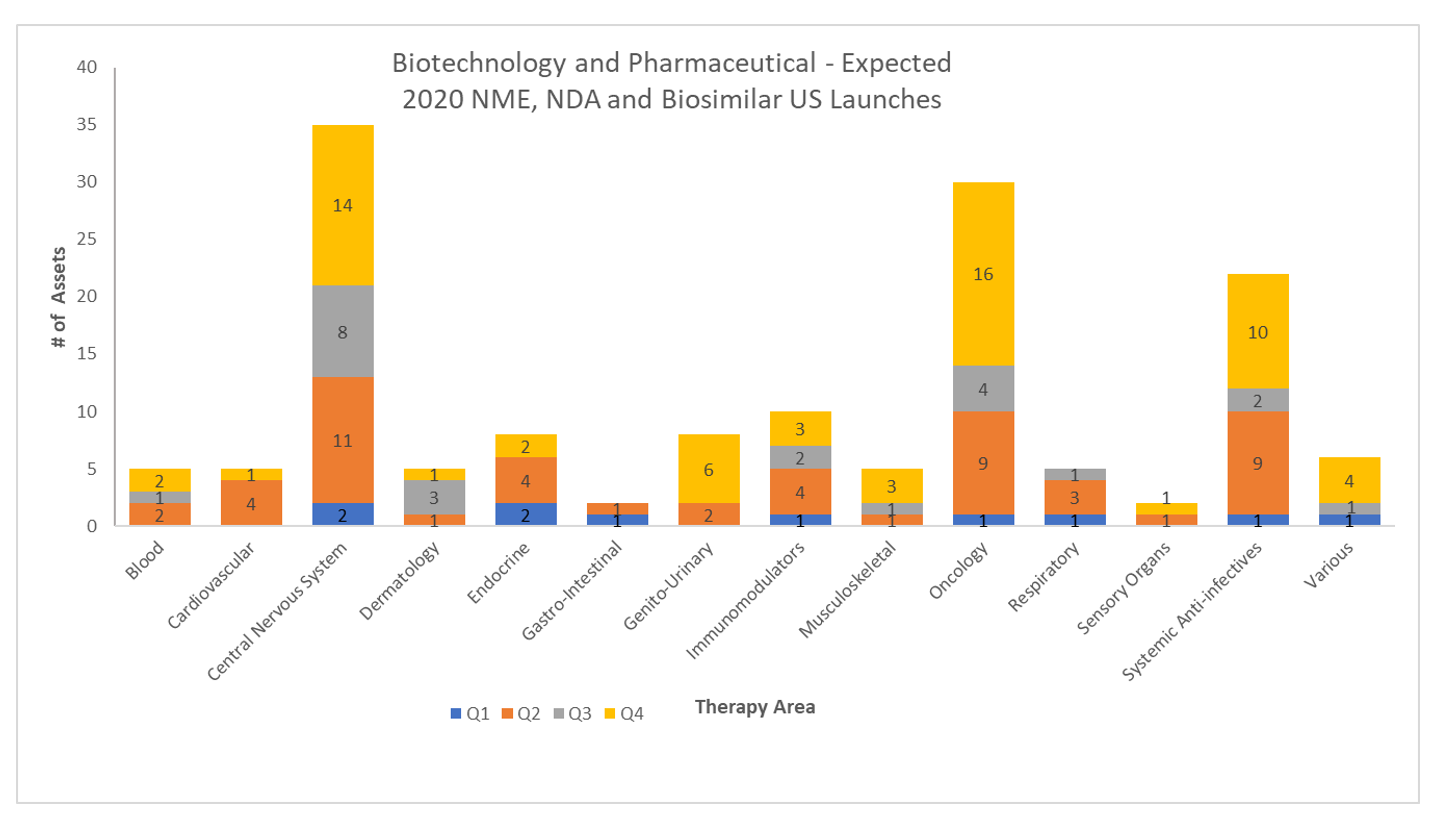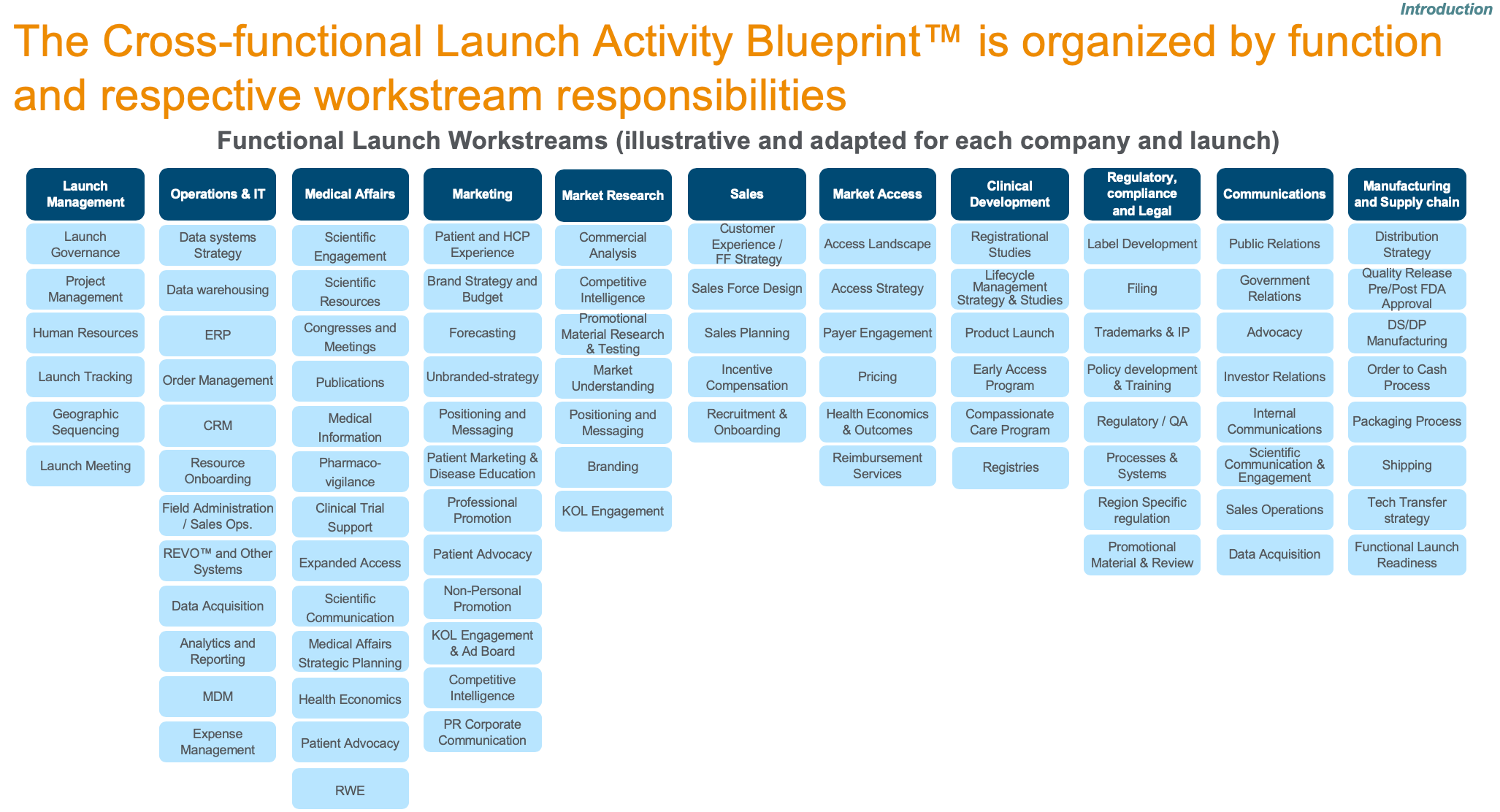Adapting Biopharma Launches in the COVID-19 Landscape
Judith Kulich and Ben Hohn pose the high priority questions that those teams opting to move forward with a launch, or to move forward after a delay, in the face of the COVID-19 pandemic.
There are approximately 156 anticipated US launches of biotech or pharmaceutical (biopharma) therapies in 2020, including NMEs, NDAs and biosimilars. Of these, 52 are anticipated to launch in Q2, 23 in Q3 and 63 in Q4, based on ZS analysis utilizing Evaluate Pharma data. The top three therapy areas for 2020 launches are central nervous systems, oncology and systemic anti-infectives (see chart below - click to enlarge).

With the sudden shift to minimize personal interaction and the refocusing of many hospitals toward COVID-19, cross-functional launch teams must reconsider whether to launch, and if so, how to change their launch execution.
Impact on timing of pharma and biotech launches
The impact of the pandemic will be greatest for launches in Q2 of this year, as many choices have been made and teams have been hired, though continuously adapting will be key. For launches in Q3, there may be a greater range of flexibility, such as deferring new hires, modifying or creating new digital campaigns and switching to virtual formats for key internal events and meetings. For launches in Q4, we are hopeful that we will be on the other side of current conditions but anticipate a Q4 ramp-up back to “normal” in 2021.
Many pipeline assets that are now in pivotal trials may be subject to delays or trials being stopped due to COVID-19, and that will mean anticipated launch dates in 2021 or 2022 will shift out by six months or potentially more (a subsequent article will focus on the launch impact for 2021 and beyond).
Should you delay your launch?
We anticipate every product launch team with a PDUFA date in Q2 or Q3 of 2020 will be asking whether to delay, and if so, for how long. Bristol-Myers Squibb announced that it would delay the launch of ozanimod, a new entrant in the competitive MS market, widely considered one of the most important launches of 2020. The delay of such a strategic launch for a big pharma company is highly unusual, if not without precedent.
On the other hand, we also expect some companies will see a delay as “not doing the right thing for patients” vs. proceeding with a launch, albeit with new constraints on face-to-face interactions. Products launching for patient populations with high unmet needs and few good alternatives may feel pressure from both advocacy groups and healthcare providers to make their products available as soon as possible. And some may be even more relevant in the context of the virus, such as products that present an alternative to surgery and thus may keep patients out of hospitals that are needed to treat COVID-19 patients.
Adapting launch readiness and global/regional functional strategy and tactics
Companies proceeding with their launches in Q2 or Q3, even after a potential delay, should re-purpose their cross-functional launch teams or designate a sub-team to quickly modify cross-functional plans and consider how best to launch. This review should look across all functions and workstreams (see a high-level illustration below, though this will vary by company and asset launch).

Click to enlarge.
There will be no “one-size fits all” COVID-19 launch blueprint, but some key questions are likely to arise as launch teams adapt their plans:
Global and regional launch rollout
• How do we adapt our global launch rollout activities by regions and support regional launches appropriately, based on both regulatory approvals and ability to launch effectively in different regions?
• In which countries should we plan for a delay, and for how long?
• Will our patients and category be impacted in this environment? Will our patients be able to see their physician for a diagnosis? Will prescribing behavior change?
Launch readiness and cross-functional coordination:
• What virtual forums should we use to engage and manage our launch team? How should we engage the broader organization (global and regional teams)?
• How do we prioritize launch investment given uncertainty in our forecast vs. what we had previously planned for?
• What tactical changes should our launch team focus on as the highest priority initiatives?
Field team
• How do we shift all field team roles, including sales, MSLs, key account management, Regional Business Directors and Nurse Educators to a virtual engagement model?
• What does “good virtual engagement” look like? How do we ensure all field teams are well prepared for this new type of skill?
• Should we implement or expand our tele-sales/inside sales team?
Commercial operations
• What does good look like for incentive compensation in a virtual environment?
• How do we adapt call plans for the current environment?
• Will our data on access and channel preferences be relevant in the current environment?
Data, analytics and systems
• What performance metrics make sense in a virtual environment? How do we measure performance?
• What virtual call tools are most effective (should we implement Veeva’s Engage tools)?
• Should we adapt/implement a launch control hub in a virtual model to anticipate, learn and rapidly respond to early launch experience and performance data?
Marketing and market research and patient programs
• What does a good HCP and patient experience look like in the context of COVID-19?
• Can we or should we shift investment towards digital? How do we gauge potential return on investment? Should we be considering targeted or mass-market DTC campaigns?
• Will launching with different engagement tactics due to the virus be viewed favorably by patients, advocacy groups and healthcare providers?
Market research
• Can/should we conduct market research?
• What does the digital patient and HCP journey look like in the current context?
• What information do we need to communicate to patients, providers and other stakeholders?
Patient programs and advocacy
• Will patients be able access their care providers, either in person or virtually?
• What are patient advocacy organizations doing for patients and how can we help support them?
• How can we rapidly adapt our patient support programs?
Medical affairs
• Major conferences like ASCO are going virtual - how will this change our engagement with KOLs? What does a virtual booth or poster session look like? Are we prepared to shift to a virtual scientific dissemination model?
• Are we prepared for an influx of inquiries about the impact of delays/limited access to medicines due to COVID-19?
• How can we continue with our market development and education programs in a virtual model?
Clinical
• How can our medical and clinical field teams support our clinical trial education programs virtually?
• How should we manage patient experience for trials that are being delayed or deferred?
• For launches further out, should we be considering adding real world evidence or registry data if current trials are impacted?
Market access, reimbursement and pricing
• How will the sudden spike in unemployment impact healthcare coverage and patient access?
• Should we consider changes to our copay or patient assistance programs?
• Will we be able to continue our market development, value communication and contracting activities virtually?
Regulatory issues
• Is the FDA likely to move our PDUFA date or review meetings? How do we plan for uncertainty?
• Will our commercial materials review be impacted? Will rules and deadlines for changing promotional materials be modified?
• For other regions, what will be the impact by country on review and approval?
Manufacturing, supply chain and distribution
• What is the potential for our manufacturing or supply chain to be disrupted?
• What can we do to minimize potential for disruption or for out-of-stock situations?
• How will we get drugs into the hands of patients who need them in this environment?
For those teams opting to move forward with a launch, or to move forward after a delay, each cross-functional launch team will need to prioritize questions and issues that are the highest priority for them to focus on within their anticipated time to launch. Teams that can quickly explore feasibility of new solutions, and organizations that empower teams to make recommendations and move work-around and alternative solutions to execution quickly will likely be more successful than those that wait for a return to “normal.”
For additional information and ZS POV in many of the areas discussed above visit https://www.zs.com/covid19.
Ben Hohn and Judith Kulich are principals at ZS and leaders of the Pipeline & Launch Strategy practice.
Addressing Disparities in Psoriasis Trials: Takeda's Strategies for Inclusivity in Clinical Research
April 14th 2025LaShell Robinson, Head of Global Feasibility and Trial Equity at Takeda, speaks about the company's strategies to engage patients in underrepresented populations in its phase III psoriasis trials.
Beyond the Prescription: Pharma's Role in Digital Health Conversations
April 1st 2025Join us for an insightful conversation with Jennifer Harakal, Head of Regulatory Affairs at Canopy Life Sciences, as we unpack the evolving intersection of social media and healthcare decisions. Discover how pharmaceutical companies can navigate regulatory challenges while meaningfully engaging with consumers in digital spaces. Jennifer shares expert strategies for responsible marketing, working with influencers, and creating educational content that bridges the gap between patients and healthcare providers. A must-listen for pharma marketers looking to build trust and compliance in today's social media landscape.
Pfizer, GSK Gain ACIP Recommendations for RSV and Meningococcal Vaccines
April 18th 2025The Centers for Disease Control and Prevention’s Advisory Committee on Immunization Practices voted to expand access to Pfizer’s respiratory syncytial virus vaccine Abrysvo for high-risk adults in their 50s and voted in favor of GSK’s meningococcal vaccine, Penmenvy, for streamlined adolescent protection.